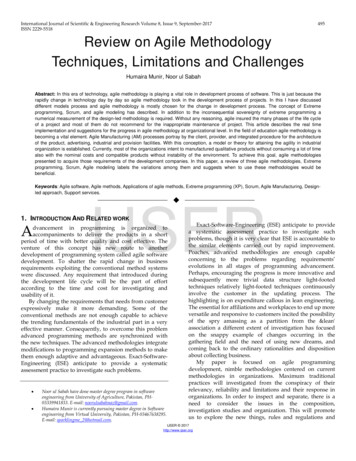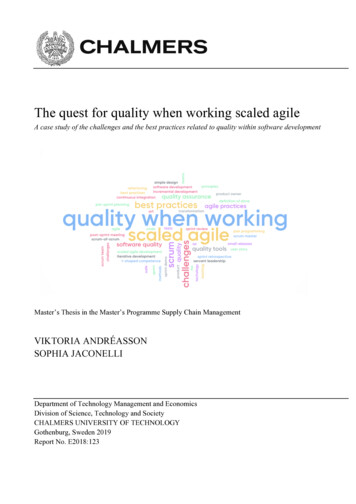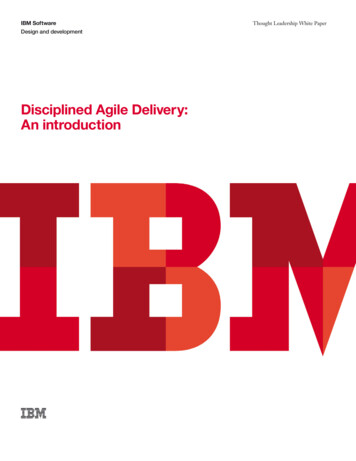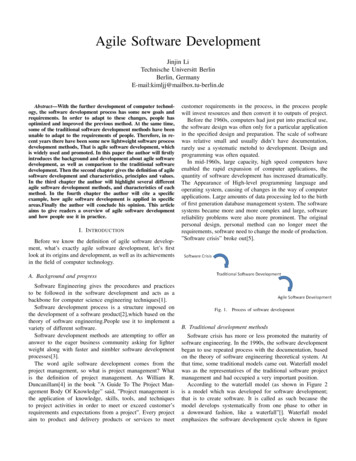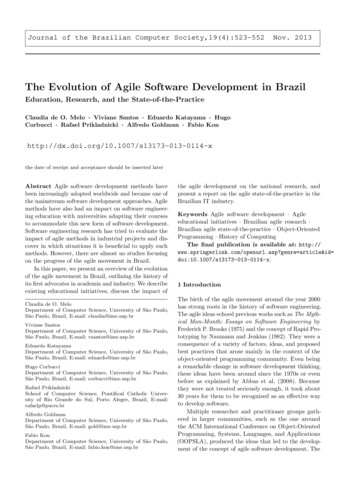
Transcription
Journal of the Brazilian Computer Society,19(4):523-552Nov. 2013The Evolution of Agile Software Development in BrazilEducation, Research, and the State-of-the-PracticeClaudia de O. Melo · Viviane Santos · Eduardo Katayama · HugoCorbucci · Rafael Prikladnicki · Alfredo Goldman · Fabio Konhttp://dx.doi.org/10.1007/s13173-013-0114-xthe date of receipt and acceptance should be inserted laterAbstract Agile software development methods havebeen increasingly adopted worldwide and became one ofthe mainstream software development approaches. Agilemethods have also had an impact on software engineering education with universities adapting their coursesto accommodate this new form of software development.Software engineering research has tried to evaluate theimpact of agile methods in industrial projects and discover in which situations it is beneficial to apply suchmethods. However, there are almost no studies focusingon the progress of the agile movement in Brazil.In this paper, we present an overview of the evolutionof the agile movement in Brazil, outlining the history ofits first advocates in academia and industry. We describeexisting educational initiatives, discuss the impact ofClaudia de O. MeloDepartment of Computer Science, University of São Paulo,São Paulo, Brazil, E-mail: claudia@ime.usp.brViviane SantosDepartment of Computer Science, University of São Paulo,São Paulo, Brazil, E-mail: vsantos@ime.usp.brEduardo KatayamaDepartment of Computer Science, University of São Paulo,São Paulo, Brazil, E-mail: eduardo@ime.usp.brHugo CorbucciDepartment of Computer Science, University of São Paulo,São Paulo, Brazil, E-mail: corbucci@ime.usp.brRafael PrikladnickiSchool of Computer Science, Pontifical Catholic University of Rio Grande do Sul, Porto Alegre, Brazil, E-mail:rafaelp@pucrs.brAlfredo GoldmanDepartment of Computer Science, University of São Paulo,São Paulo, Brazil, E-mail: gold@ime.usp.brFabio KonDepartment of Computer Science, University of São Paulo,São Paulo, Brazil, E-mail: fabio.kon@ime.usp.brthe agile development on the national research, andpresent a report on the agile state-of-the-practice in theBrazilian IT industry.Keywords Agile software development · Agileeducational initiatives · Brazilian agile research ·Brazilian agile state-of-the-practice · Object-OrientedProgramming · History of ComputingThe final publication is available at: http://www.springerlink.com/openurl.asp?genre article&id doi:10.1007/s13173-013-0114-x.1 IntroductionThe birth of the agile movement around the year 2000has strong roots in the history of software engineering.The agile ideas echoed previous works such as The Mythical Man-Month: Essays on Software Engineering byFrederick P. Brooks (1975) and the concept of Rapid Prototyping by Naumann and Jenkins (1982). They were aconsequence of a variety of factors, ideas, and proposedbest practices that arose mainly in the context of theobject-oriented programming community. Even beinga remarkable change in software development thinking,these ideas have been around since the 1970s or evenbefore as explained by Abbas et al. (2008). Becausethey were not treated seriously enough, it took about30 years for them to be recognized as an effective wayto develop software.Multiple researcher and practitioner groups gathered in larger communities, such as the one aroundthe ACM International Conference on Object-OrientedProgramming, Systems, Languages, and Applications(OOPSLA), produced the ideas that led to the development of the concept of agile software development. The
2Claudia de O. Melo et al.role of the Smalltalk programming language community was also fundamental. Three important points fromthat community led to changes. The first was Smalltalk’sminimal syntax that let programmers write code thatlooked like natural language sentences. The first wasSmalltalk’s minimal syntax that let programmers writecode that mimics natural language sentences (Ducasse2005). For example, well written Smalltalk code canlook like a sentence in English, e.g., Clock display Timenow. The second was its dynamic typing that providedhigh flexibility. Lastly, a powerful programming environment centered around its dynamic and flexible classbrowser that influenced modern IDEs. Due to thesecharacteristics, Smalltalk fostered the development ofthe technology and the spirit that enabled a differentway of developing software.During the 1990s, a combination of factors produceda fertile land for the growth of agile ideas (Abbas et al.2008). First, there was a reaction to heavyweight, prescriptive approaches to software development. Second,the increasing level of change in the business environment urged practitioners to handle complex and unpredictable requirements in systems development. Thus,practitioners started to revisit old alternative ways of developing software such as the iterative and incrementaldevelopment and close customer involvement proposedby Winston Royce (1970), test-first development andcontinuous integration used by NASA’s 1961-63 ProjectMercury described by Larman and Basili (2003), andrapid prototyping defined by Naumann and Jenkins(1982).In the second half of the 1990s, research and practicalresults in the fields of OOP, design patterns, automatedtesting, refactoring, and the like, produced a commonmind-set that drove the definition of multiple softwaredevelopment methods that had the core agile principles in common (Goldman et al. 2004; Cockburn 2006).These methods include Extreme Programming (XP),Scrum, Dynamic Systems Development Method, Adaptive Software Development, Crystal, Feature-Driven Development, Pragmatic Programming, and others.In early 2001, a group of independent practitionerswith a strong link with the software industry and aweaker, but still relevant, link with research groups fromacademia decided to join forces and founded what waslater called the agile movement. To make these ideasmore concrete, 17 software experts met from February11th to 13th in the mountains of Utah, USA, to collectively craft the agile manifesto1 . The goal of the manifesto was to bring attention to the idea that to producehigh-quality, valuable software, development teams mustfocus on values and principles such as (1) individuals1www.agilemanifesto.organd interactions, (2) working software, (3) customer collaboration, and (4) responding to change. Those pointswere presented as more important than emphasizing processes and tools, comprehensive documentation, contractnegotiation, and following previously-defined plans.Agile methods are, thus, concrete approaches to materialize the manifesto’s values and principles towardsagility. Agility can be interpreted as the capability of“rapidly or inherently creating change, proactively orreactively embracing change, and learning from changewhile contributing to perceived customer value (economy,quality, and simplicity), through its collective components and relationships with its environment”(Conboy2009).A year before the manifesto, some of the ideas fromthe agile movement were already making their way intothe Brazilian software development community. Initiatives in São Paulo, Rio de Janeiro, and Curitiba appeared around 2001 and grew to a conference in 2002(Extreme Programming Brasil’2002). A couple of yearslater, academic courses, conferences as well as industryadoptions were starting to create a community of agilepractitioners. Nowadays, that community has expandedenough to make agile methods a widely accepted software engineering alternative in Brazil, with a strongindustry market in training and a growing demand fromboth the private and public sectors.After more than ten years of the agile manifestoformalization, the agile methods relevance and community in Brazil continue to grow. In a preliminary study(Corbucci et al. 2011), we presented an overview of theevolution of the Agile Movement in Brazil, describedexisting educational initiatives, and reported the agilestate-of-the-practice in the Brazilian IT industry. In thecurrent paper, we extend and refine that work. Ourstudy aims now to provide a better understanding ofthe agile software development evolution in the country,particularly in education, research, and the industry.This research focus on the following research questions:– RQ1. How agile methods education has evolved inBrazil?– RQ2: How agile methods research has evolved inBrazil?– RQ3: How agile methods practice has evolved in theBrazilian IT industry?The rest of this paper is organized as follows. Section 2 describes the first agile methods advocates inacademia and industry. Section 3 describes an experience report of a pioneering education initiative on agilemethods and also gives an overview of other coursesconducted since 2001. Section 4 presents the impact ofthe agile movement in research, and Section 5 presents
The Evolution of Agile Software Development in Brazila recent comprehensive study of agile methods impactin Brazilian IT industry. Section 6 discusses the mainfindings and implications for research and practice, aswell as limitations of the current work. The last sectionconcludes the paper and describes future work.2 The GenesisAgile methods and the agile movement itself becameknown worldwide in 1999, the year in which Kent Beck’sXP book (Beck 1999) was published and released duringthe ACM OOPSLA conference in Denver, Colorado. In2000, the 1st International Conference on eXtreme Programming and Agile Processes in Software Engineering(XP’2000) took place in Sardinia, Italy. At this time, afew Brazilian software developers and researchers fromacademia and industry got in touch with the movement.Some of these people attended XP’2000 and met keyfigures from the movement, such as Kent Beck, AlistairCockburn, Martin Fowler, Ron Jeffries, and Robert Martin. Others were at ACM OOPSLA in 1999 and 2000,attended Beck’s talks and got involved with the bigfrisson that XP and agile methods made during thoseconferences.In early 2001, Brazilian professors and practitionersstarted to give talks about extreme programming inuniversities, government IT departments and in companies related to the software industry. In that year,the first full-semester university courses on extreme programming started to be offered. In this courses, studentswould develop real software projects using all the XPpractices rigorously. Evaluations made with the studentsshowed that these were among the most popular elective courses in the curriculum. Dozens of these studentswent out to work in the software industry shortly afterthe courses and often started to disseminate agile methods in their new organizations. Some of the advancedstudents with more leadership skills started to act, after their graduation, as consultants and project leadersand helped to introduce agile methods into even moresoftware development companies.In the few years after 2001, the members of thisinitially small agile methods community (including academics such as Vinı́cius Teles, Fabio Kon, and AlfredoGoldman and practitioners such as Klaus Wuestefeld)gave tens of lectures and short courses on extreme programming and agile methods throughout Brazil to boththe academic and industrial audiences. Events in 2002and 2003 in São Paulo, Rio de Janeiro, Recife, Florianópolis, So Carlos, and Brası́lia were fundamental indisseminating the practical use of these methods in realsoftware development projects in Brazil.3By that time, the private sector organized ExtremeProgramming Brasil’2002, the first agile event in Brazil,which featured Kent Beck’s first and only visit to thecountry. It was held in São Paulo during 3 days at thebeginning of December and had Scott Ambler and RobMee along with Kent Beck as international guests givinglectures to around 200 participants. Brazilian professorspresented their experience teaching XP in the universities and practitioners described their first experienceswith the new methods in the national software industry.Two years later, Extreme Programming Brasil’2004was attended by 300 people and brought Mary and TomPoppendieck with the support of several companies. Inthe subsequent years, events at the University of SãoPaulo brought world class speakers from the field such asFrederick Brooks, Linda Rising, Richard Gabriel, JuttaEckstein, Joe Yoer, and Brian Foote. Agile methodswere starting to gain strength both in the academia andin the industry.In 2010, graduate students and industry professionals organized the first edition of Agile Brazil. Since then,each year, the conference has been attracting over 800attendees from all over the country. Agile Brazil hasbecome the most important Brazilian conference on agile software development. It brings not only a series oftalks and workshops for the industry, but also an academic workshop, an executive summit, and a marathonwith training courses to disseminate knowledge on agilemethods.3 Agile Methods EducationThere were several educational initiatives on promotingagile methods in Brazil within the Academia and Industry. To answer our RQ1: How agile methods educationhas evolved in Brazil?, we first describe an experience report from the course “Extreme Programing Laboratory”,the oldest course about agile software development running in the country. Our report includes details aboutthe context, techniques, and the course developmentthroughout the years. We illustrate some specific resultsby referring to published papers regarding the projects.After that, we describe some other Brazilian educational initiatives based on our research group knowledge.Despite our description is not complete, we aim to contribute by adding anecdotal evidence from some of thefirst education courses given in Brazil.Extreme Programing Laboratory at IME-USP The oldest and still running course on agile software development in Brazil is probably the course Extreme Programing Laboratory at IME-USP, which became a space fordeveloping several real projects. It occurs once a year
4Claudia de O. Melo et al.for Computer Science undergraduate and graduate students, during a full semester. The first edition was in2001, when three professors taught a dozen students.Since then, the course has evolved and scaled up to overfifty students in eight concurrent projects and teams.To support such growth, beyond the teacher’s role,there are some very experienced students that assumeteaching assistant roles and work as meta-coaches during the courses. Meta-coaches are supposed to serveas experts for all groups providing feedback, supervising the practices and helping with the adoption of newpractices. Also, former students or experienced studentsare encouraged to assume a coaching role in the following editions, and the other enrolled students work asdevelopers.To set up a closer to real environment, IME-USPcourse customers are chosen from several universityrequests or open source projects2 . All the systems developed are available as free software. The course startswith three weeks of theoretical classes, when the basicsof agile methods and XP are introduced; then, the students can choose the projects they are willing to workon. Usually, each project gets from four to eight participants. If there is no experienced student on the group,a coach is elected among the volunteers. The groupswithout an experienced coach receive more attentionfrom the meta-coaches.IME-USP course requires 8 hours per week of dedication by students. The initial practices adopted at thestart of the projects are the 12 from the first edition ofthe XP book; in addition, daily stand-up meetings andinformative workspaces are also used. All teams haveto carry out retrospectives at the end of each iteration.Once a week, there is a meeting involving coaches, metacoaches and the teacher for project reviews, sharing ofissues or solutions, and requesting support. The teacherand meta-coaches monitor teams’ agile practices, evaluate their informative workspaces and progress, andalso collect students’ feedback on the course to adapt itaccording to the students’ learning needs. To grade thestudents, an average of grades for attendance, pro-activeparticipation, tracking, customer satisfaction, along withpersonal, coach, and meta-coach evaluation is calculated.In order to accommodate the entire class, physicaland technological infrastructure is provided. Thus, thecurrent learning environment is composed of two laboratories as working areas for the teams, material formaking the informative workspaces3 (Beck 1999), plan2Projects’ description available at www.ime.usp.br/ xp/projects.php3 This includes white boards, all-size and color post-its, pens,pencils, erasers, story cards, posters, rulers, boxes, colorfuladhesives, adhesive tapes, and others.ning poker decks for estimations (Williams 2010), tworooms for planning, technical and customer approvalmeetings, and retrospectives (Derby and Larsen 2006).This way, the XP Laboratory course at IME/USP replicates a system similar to the industry and is of greatvalue to students, as a student stated: “the course gaveme much opportunity to learn how to manage a teamand negotiate projects with a client”.In a recent endeavor to improve the course continuously, once a week there is a one-hour class duringlunchtime with lunch afforded by the course for scrutinizing XP topics through mini-lectures. The topics arepreviously chosen by the students. and through otherpractices applied to gather feedback on the course, andenhance interaction among the members of the course.The applied practices were Coding Dojo (Sato et al.2008), whole-class retrospectives, and other meaningfuldynamics commonly used in agile methods conferences,known as Lightning talks4 , Birds of a feather sessions5 ,Starfish diagrams6 , Brainwritting7 , and workshops.Considering the success of the first editions of IMEUSP XP laboratory, a presentation on its concept wasgiven in the Brazilian Quality Symposium in 2002, aforum where good teaching ideas and techniques arespread among different Universities, during the annualcongress of the Brazilian Computer Society (SBC). Lateron, using the course as a test bed, several scientific publications were produced, addressing multiple topics, fromworking software such as Archimedes (Corbucci andBravo 2007), Mezuro (Meirelles et al. 2010; Terceiroet al. 2010) and Mico (Silva et al. 2004) to experimentson teaching XP (Goldman et al. 2004) or XP relatedtechniques (Bravo and Goldman 2010). Three recentstudies on tracking (Oliveira et al. 2013), continuousimprovement (Santos and Goldman 2010), and organizational learning (Santos and Goldman 2011) have alsoused the XP lab environment.Other academic courses On the second semester of 2011,a semi presencial setting was tried on an XP laboratorycourse given on a different Brazilian state. On this special edition, the course was given to 15 PhD studentsin the period of two months. After the initial lectureson XP practices, the professor visited the students twotimes during the development process and one last time4Short presentations to share ideas. Next, if appropriate, abrief discussion may occur.5 Informal discussion group where the attendees group together based on shared interests.6 Diagram to get feedback of what to stop or start doing,and what to have more or less of, introduced by Patrick starfish.7 A brainstorming activity to encourage cross-team interaction by using cards to propose solutions to projects’ issues.
The Evolution of Agile Software Development in Brazilat the end of the project. To overcome distance problems, some approaches were taken: an environment wasset up to allow a distributed tracking of the projects,each student was responsible for reading, and possiblysharing, some agile methods related material, and allthe discussions were done (or commented on the mailinglists). The feedback provided by the students was verypositive, as a student reported: “The general set up ofthe course was very good: a theoretical introductionon XP, auxiliary reading requests about related topics,and lots of practice (.) I learned a lot in these twomonths, but still, I learned more about my personal andteam experiences”. Also another student outlined: “Thediscipline is very practical, which is very stimulating. Ienjoyed dealing with customers and systems that wouldbe actually used.”A similar initiative on teaching XP was carried outat the Federal University of Rio de Janeiro (UFRJ)starting in the second semester of 2002. The approachused in Rio was different. There were two parts on eachlecture: first a theoretical one in which the studentshad to answer questions orally based on the materialprovided earlier. For the practical part, instead of havinga project for each team during the whole course, severalshort exercises on each practice were proposed. Themotivation was to reinforce the learning of each practice,always practicing pair programming. Each day, the pairswere randomly chosen. The grades were mainly givenbased on the attendance and on the answers.It is interesting to observe that other prominentcenter on agile research, Federal University of Recife(UFPE), used a different approach. Instead of havingan initial focus on education, they started from thebeginning with research. In 2003, two Masters thesisrelated to agile methods and one term undergraduatepaper were presented. Since then, there has been anincreasing number of graduate and undergraduate works,including those from other universities in that state, suchas the Federal Rural University of Recife (UFRPE).In addition to the initiatives described, we also identified several other initiatives on teaching agile methodsthat were developed in the last three years within manyuniversities in Brazil. At PUCRS, for example, in thesouth of the country, there is a 3-course program onagile methods that is offered every year by the Schoolof Computer Science. The courses involve an introductory course, agile project management with Scrum andagile business analysis. More recently, PUCRS has engaged in another initiative, which involves the creationof an agile laboratory financed by CNPq (the Brazilianfunding agency) to develop high performance softwaredevelopment teams, based on agile methods.5On the industrial side, a few companies provide training on agile methods. For example, Caelum is a Braziliancompany whose business includes both training and software development. Caelum has several short courses onJava and object-oriented development. The companystarted to offer courses on XP and Scrum in 2007. However, the XP course was shortly discontinued since theindustrial demand at that time was not enough. Lateron, in early 2010, the Scrum course was reformulatedto address agile methods in general, focusing mainlyon the management practices. By the end of the sameyear, a new course was created to cover more technicalpractices such as unit and acceptance tests, test-drivendevelopment, and refactoring.In 2006, as agile methods started to gain wide acceptance, some professors and students at IME-USPdecided to offer a summer course to promote those ideasbeyond the limits of the university. It was a 20-hourtheoretical course spread along 5 days with 2 instructors each day. The result was a success and all teachingmaterial was published at the Agilcoop website8 to beused freely under a Creative Commons license. In thefollowing three years, the team of instructors continuedto offer the course, adding topics such as an eXtremeProgramming Laboratory to offer a more practical approach and a testing course to study that subject moredeeply. During this time, over 200 people attended thetheoretical course, over 60 attended the practical courseand around 50 were in the testing course. Most of this300 participants were from the industry and helped todisseminate agile practices in their companies.Scrum (Schwaber and Beedle 2001) was also a veryimportant player in the agile methods growth. Althoughit has its origins earlier than XP, it became widelyknown only around 2006 when the Scrum Alliance9 (anonprofit organization) became a corporate entity andstarted a certification process to gather professionalsthat met their criteria. The alliance offers several certification stamps that can be given only by certifiedtrainers. Initially, all certifications given in Brazil wereoffered by foreign trainers in English. Since August 2008,though, the first Brazilian Certified Scrum Trainer wererecognized by the Scrum Alliance and courses startedto be taught in Portuguese. The certification filled animportant gap to the industry as it presented a wayto prove the knowledge of companies on agile methods.Since then other Brazilians obtained the CST certificate and the demand for certified scrum courses neverstopped growing. Recently, a discussion regarding thecertification led to the creation of another foundation89http://ccsl.ime.usp.br/agilcoop/curso de verao 2007http://www.scrumalliance.org
6(Scrum.org10 ) separating Ken Schwaber (Scrum.org) andJeff Sutherland (Scrum Alliance), and provoking a rupture in the Scrum community. This new association alsooffers a certification program under a different label(Professional Scrum Certifications).More recently, PMI (Project Management Institute)also launched an agile certification, called PMI-ACP(Agile Certified Practitioner)11 . The PMI-ACP recognizes knowledge of agile principles, practices and toolsand techniques across agile methodologies. As statedby PMI, “individuals with experience working on agile project teams can apply”. The pilot of PMI-ACPoccurred from Sept 15th 2011 to Nov 30th 2011, withmore than 500 tests. So far, 13 Brazilians have passedand now earn the PMI-ACP certification. The fact thatcertification systems are a success in industry is undeniable and many people got in touch with agile throughthese certification programs.Another initiative to foster the adoption of agilemethods was done in several editions of the EncontroÁgil workshop12 . In the first editions, the main focuswas on tutorials and panels to teach or provide workingevidence on agile methods and related techniques. Toprovide interesting information for a broad audience,the workshops were divided in three main categories,Keynote talks usually with an invited speaker, an advanced track, and an introductory track. However, in thelast edition in 2010 there was a major change. Insteadof providing talks, a larger emphasis on open spaces andlightning talks was given while only workshop with moreinteractive possibilities were allowed as long sessions.Finally, in 2003, a tutorial on agile methods and XPwas presented at SBES. This was the predecessor ofa new tutorial held at CBSOFT-SBES on 2011 aboutagile methods. The new tutorial’s main motivation wasto present evidence on the effectiveness of agile methodsafter ten years of their use in Brazil and to show thecurrent challenges.Worldwide, there are several studies pointing out theadjustments in curricula on software engineering education to conform to this new paradigm (Rico and Sayani2009) (Bunse et al. 2004) (Muller et al. 2004) (Hazzanand Dubinsky 2003) (Melnik and Maurer 2003) (Wainer2003). These studies propose ways to accomplish this,but most of them consider it a challenging endeavor,since it requires theory and hands-on experience, realprojects, time for the development work, place for building the agile environment, and the presence of severalroles (like customer, coach, developer, and ertification/New-PMI-Agile-Certification.aspx12 http://www.encontroagil.com.br11Claudia de O. Melo et al.4 Agile Methods ResearchTo the best of our knowledge, the first review of Brazilianacademic papers on agile software development waspublished in the Brazilian Workshop on Agile Methods(WBMA’2011) (Goldman and Katayama 2011). Here,we extend those results adding research papers publisheduntil December 8, 2011. As in the original paper, weaim to answer RQ2: How agile methods research hasevolved in Brazil?.4.1 Review ProcessTo focus the design of the review process, we dividedthe RQ2 into three sub-questions:– SQ1. How many thesis and dissertations related toagile software development are in progress and havebeen concluded in Brazil?– SQ2. How is the collaboration and cooperation amongresearchers in Brazil?– SQ3. How many bibliographical, technical productions related to agile software development wereelaborated in Brazil?Our review process encompasses four stages:Stage 1. Identify researchers. The first part of the review process consisted in identifying Brazilian researchers working on fields related to agile methods.The search strategy included a list of contacts ofresearchers and manual searches on national conferences proceedings such as WBMA (SBC 2011c),ESELAW (SBC 2011a), WDRA (SBC 2011d) andSBES (SBC 2011b), and international conferencessuch as Agile (Dingsøyr et al. 2011) and XP (Sillittiet al. 2011). For each identified researcher, we senta personal email communication for validating thedata. We also asked them to invite their researchcontacts related to agile methods to help validatethe data.Using scriptLattes (Mena-Chalco and Cesar-Jr 2009),an open-source knowledge extraction system for theLattes platform, we conducted a literature search inthe Lattes Curriculum13 on December 8th, 2011 toextract scientific productions and ongoing/concludedthesis supervisions. We chose to use the Lattes Curriculum because most national publications have notbeen indexed in other electronic databases, as ISIWeb of Science.13 The “Lattes Curriculum” is considered a Brazilian standard of information about the scientific and academic production of students, professors, researchers, and professionalsinvolved in science and technology in general.
The Evolution of Agile Software Development in BrazilStage 2. Identify relevant work. Papers were includedin the revi
The Evolution of Agile Software Development in Brazil Education, Research, and the State-of-the-Practice . Programming, Systems, Languages, and Applications (OOPSLA), produced the ideas that led to the develop- . Programming Brasil'2002, the rst agile event in Brazil, which featured Kent Beck's rst and only visit to the country. It was .



